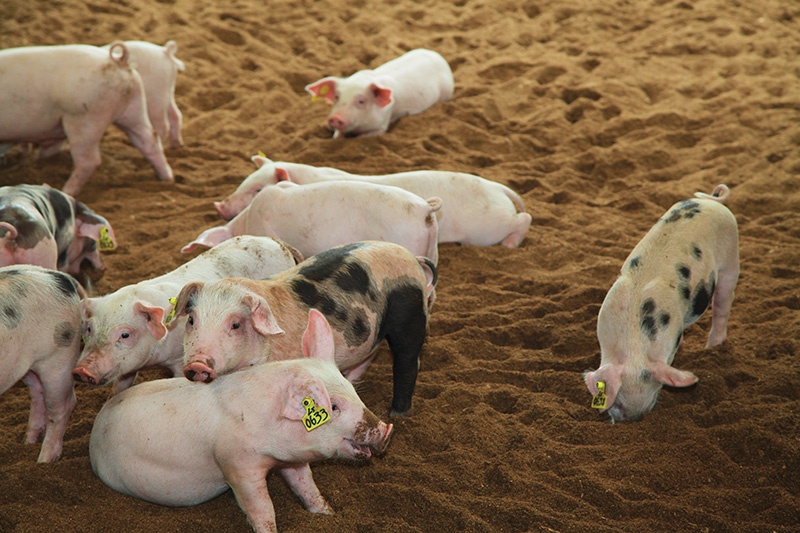Stability sought for variance in local sales
 |
| The fluctuations of live pig prices require united efforts from farmers, localities, and management agencies |
Both livestock companies and farmers are suffering from variance in sale prices. Between March and September, the price dipped from an average of $3.25 to $2.15 per kg, plunging further in October to as low as $1.75. Many businesses are also attempting to sell off overweight pigs for even less, in some cases down 50 per cent compared to mid-2020. For instance, C.P. Vietnam Livestock has been selling overweight pigs from around $1.60 per kg.
The representative of a foreign-invested livestock company told VIR that the company has a large volume of commercial pigs, and it has been projected that it will take at least two months to consume the unsold products. “There are currently other large amounts of mature pig to be sold in the coming months, thus it causes serious overload for the market.”
“If the selling price falls to $1.50 per kg, the company will suffer a loss of 69 US cents per kg. The cost for growing pigs has increased, including in materials for feed production, maintaining pandemic stay-at-work models, and incurred expenditure for transporting products across localities this year.”
In general, livestock companies are reporting zero profits in August and September and losses for October, the representative said.
The variation is so serious that the government has organised an extraordinary meeting to determine reasons and look for solutions.
According to Deputy Minister of Agriculture and Rural Development (MARD) Phung Duc Tien, a sharp reduction in pig prices in the domestic market has been caused by the complications of the pandemic, including social distancing, operation disruptions, and lowering demand for products.
“Although social distancing has been loosened, demand has yet to recover as before,” Tien said.
In a meeting between representatives of the MARD and livestock companies and associations organised last week, Vu Anh Tuan, senior vice president of C.P. Vietnam, emphasised the role of animal feed in breeding, equivalent to 60 per cent of total costs. Meanwhile animal feed costs, which depends on around 90 per cent of imported materials, are increasing by 16-36 per cent on-year.
Logistics costs are also causing headaches, meaning such companies are generally spending an additional 9 US cents per kg for animal feed. It is forecasted that in the early-2022, the reduction of freight rates will gradually reduce the cost of animal feed. “In order to proactively supply animal feed, breeding enterprises need supporting mechanisms to develop the production of animal feed made from local raw materials,” said Tuan.
Nguyen Thanh Son, chairman of the Vietnam Poultry Association added, “It is necessary to reduce import tax on animal feed materials and input materials, as well as credit support and bank interest rates, for production facilities to reduce input costs and ensure food supply heading towards Lunar New Year.”
Resolution No.128/NQ-CP dated October 11 is promoting the resumption of wet markets and socioeconomic activities, which Son says means demand will certainly rise, leading to an increase in the price of livestock products. “However, in the long term, it is necessary to build a strategy of developing animal feed materials, which will not be heavily dependent on imports as like present,” added Son.
Indeed, due to the sharp increase in production costs, numerous farmers and similar facilities have already stopped breeding because they do not have enough capacity to re-herd, and it is too difficult for them to borrow money from credit institutions.
In order to stabilise breeding, processing, and consumption of livestock products, associations are suggesting strengthening connections and supporting cooperative groups, farms, and companies to expand the market, bringing products to supply directly through existing distribution chains.
Vu Thi Hau, chairwoman of the Vietnam Retailers Association, said that modern retailers like supermarkets are not dependent on price fluctuations. However, due to the fresh food products, modern retailers do not have enough large storage and processing warehouses, so the selling price depends entirely on the suppliers.
“We sign contracts with large suppliers only to ensure quantity and quality. However, if the links between producers and distributors is not good, the price will fluctuate also. Therefore, we need sanctions to ensure close cooperation between producers and consumers,” emphasised Hau.
Deputy Minister Tien said that the ministry has already asked the government to consider a bailout for farmers, in the form of cuts in corporate income tax or environmental protection tax, and VAT payment delays, among other options.
“Over half of pig breeders across the country are small farming households. To stabilise breeding and consumption, we should develop horizontal and vertical chains and if export activities develop, local production will get stronger and enterprises can then further invest into the chains,” Tien noted.
| Le Van Thanh - Deputy Prime Minister
The difference between the selling price of live hogs and the price of meat at markets is unacceptable, which needs the intervention of the state, especially after a few months of social distancing during during which numerous markets closed and demand on food dropped. We need synchronous measures to boost breeding, production, and consumption, in harmonisation with the interests of various parties like farmers, companies, and consumers, in addition to financial support. Besides these steps, ministries, agencies, and large economic centres should accelerate the recovery. The Ministry of Trade and Industry should speed up the resumption of wet markets in line with Resolution No.128/NQ-CP, and stabilise prices to boost consumption. It is necessary to identify the costs and benefits of every stage in the value chain, as well as the differences between the selling price of live hogs and fresh meat at markets. The Ministry of Agricultural and Rural Development should pay more attention to controlling both purchasing and selling prices of both input and output products, as well as animal medicines, and build up a re-herd plan in line with the movements of the market, especially at the end of the year and towards Lunar New Year. The Ministry of Transport should also remove obstacles in the transport of goods across the country, making it easier for farmers and businesses to deliver goods and approach retailers and consumers. | |
| Nguyen Kim Doan - Vice chairman, Dong Nai Animal Husbandry Association
It is difficult to predict the fluctuation of pig prices in the last months of this year because the price changes depend on purchasing power after the pandemic, including the recovery of markets, restaurants, eateries, and school kitchens. In order to avoid the oversupply of pigs in the long term, it is necessary to build frozen warehouse chains for unmarketable pork. It is necessary to have quotas for pork imports and the number of pigs for producers based on supply and demand. In order to export livestock, the government should create favourable conditions for enterprises to build slaughterhouses with modern facilities as an important factor for them to negotiate with partners overseas. | |
| Bui Bich Lien - CEO Thuy Thien Nhu Farm
Breeding and livestock production remain unplanned, without official overview and guidelines for farmers to develop production and build up business plans. Meanwhile, animal husbandry usually struggles with numerous external factors such as weather, epidemics, and market prices. Both raw materials and labour costs have increased by 20-30 per cent, in addition to the costs of pandemic prevention, quarantines, transportation, and intermediaries. The cost of livestock production raised sharply, but the selling price of live hogs did not change accordingly, despite fluctuations at markets and supermarkets. Thus, the surrounding difficulties are eroding opportunities, unless there are supportive policies from the state’s agencies. The policies to support livestock enterprises are so far insufficient. and conditions are too challenging for a large number of businesses to meet. |
What the stars mean:
★ Poor ★ ★ Promising ★★★ Good ★★★★ Very good ★★★★★ Exceptional
Related Contents
Latest News
More News
- Opening remarks of 14th National Party Congress (January 20, 2026 | 09:44)
- First working day of 14th National Congress of Communist Party of Vietnam (January 19, 2026 | 08:54)
- Viettel starts construction of semiconductor chip production plant (January 16, 2026 | 21:30)
- Redefining Vietnam’s growth model for the era of innovation (January 16, 2026 | 16:40)
- Foreign sentiment towards Vietnam turns more positive (January 15, 2026 | 11:08)
- Vietnam ranks 38th in global AI adoption (January 14, 2026 | 16:01)
- European business confidence reaches highest in seven years (January 13, 2026 | 10:17)
- UOB lifts Vietnam growth outlook to 7.5 per cent for 2026 (January 10, 2026 | 09:00)
- Vietnam leads ASEAN in EV market growth (January 09, 2026 | 14:39)
- Electronics drive Vietnam’s trade growth as exports hit record in 2025 (January 07, 2026 | 10:23)




 Tag:
Tag:


















 Mobile Version
Mobile Version